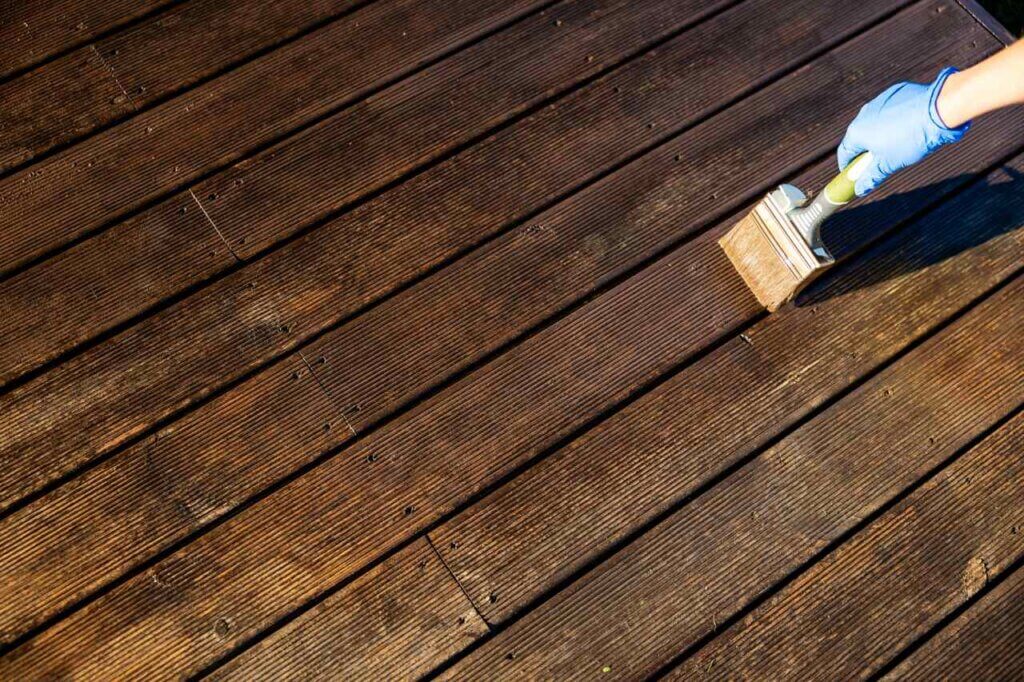How to Protect Composite Decking: Full Guide
Find out how protecting your composite decking can help keep your decking looking its best for years to come. You
Products in Stock
Lowest Prices
Express Delivery
10-Year Warranty
Early June Sale. Up To 15% Off.

Got a wooden deck that’s starting to look a bit tired? You might be wondering when it’s time for a fresh coat of stain or sealant. Most homeowners aren’t sure how often they should be maintaining their decking, and it’s easy to get it wrong. Too frequent and you’re wasting time and money. Too infrequent and you’ll end up with a weathered, damaged deck that might need replacing much sooner than it should. Let’s sort out this confusion once and for all.
Think about it – your deck cops a beating all year round. Rain, sunshine, frost, snow, barbecue spills, muddy boots… the works. Without protection, timber doesn’t stand a chance.
Ever seen what happens to an old fence post after a few British winters? It rots, splits and eventually fails. The same goes for your deck. A good sealant stops water getting into the wood grain where it would otherwise cause havoc. Given our famous UK weather (read: lots of rain), this is dead important.
Left alone in the sun, even the nicest timber deck will fade to a sad, grey shadow of its former self. Those lovely wood tones you paid for will disappear, and worse – the surface can crack and splinter. Not what you want under bare feet.
We’ve seen decks last 20+ years with proper care, while neglected ones sometimes need replacing after 5-7 years. Bit of a no-brainer when you work out the cost difference. And if you’re thinking about a new deck or replacement, you might want to explore our full decking range – and remember, we’ll always send you a free sample so you can try before you buy. Or should we say, try before you build?
So what’s the magic number? For most wooden decks in our lovely British climate, you’re looking at treating them every 1-2 years. But it’s not quite that simple.
Got a pine deck? You’ll need to roll up your sleeves yearly. These softwoods are thirsty and need regular protection. Splashed out on hardwood like oak or ipe? You might get away with treatment every 2-3 years. They’re tougher cookies altogether.
The product you choose makes a difference too. Water-based sealants are easier to work with but need redoing every 1-2 years. Oil-based products are messier to apply but typically last 2-3 years before they start to fail. Swings and roundabouts.
Clear finishes look gorgeous but wear fastest – expect annual reapplication. Semi-transparent stains might last 2 years, while solid stains can go 3-5 years between coats. The more pigment, the more protection.
Let’s be honest – blanket rules are a bit rubbish when it comes to deck maintenance. Your situation is unique, and these factors will push you toward either end of the timeframe:
Got a south-facing sun trap? Your deck’s getting hammered by UV rays and will need more frequent TLC. Meanwhile, that shaded deck tucked away might last longer between treatments. Location matters more than you’d think.
If your deck’s party central every weekend or the main route to your garden, those areas will wear faster. The path from your back door to the BBQ? That’ll need attention before those quiet corners where only the cat sits.
Living in the Lake District or Scotland? You’ll need to seal more often than someone in the drier southeast. Constant damp is the sworn enemy of wooden decking. Some regions just demand more maintenance – blame the weather.
A deck sitting directly on the ground stays wetter longer than one with good air circulation underneath. Poor drainage equals moisture lingering equals faster deterioration. Physics isn’t on your side here.
Can’t remember when you last treated your deck? No worries. Your deck will practically scream at you when it needs attention. Here’s what to watch for:
Chuck some water on your deck. Does it form little beads that just sit there? Great, your seal’s still working. Does it soak in like water into a sponge? Time to get the sealant out. This is your number one indicator.
Has your warm, honey-toned deck started looking grey and sad? Or gone all patchy with some areas darker than others? That’s the protective layer waving the white flag. Time for reinforcements.
When you start getting splinters in your feet or seeing little cracks appearing, you’ve waited too long. The wood is already damaged and absorbing moisture. Sort it quick before it gets worse.

Not sure if your deck’s ready for another coat? Here’s a dead simple test that never lies:
Grab a glass of water and flick a few drops onto your deck. Then watch what happens. Water beading up on the surface? You’re golden – the seal’s doing its job. Water soaking in within 10 minutes? Sorry mate, time to break out the sealant. Not sure how to tackle the job? Explore our complete guide to applying decking sealer where we walk you through it step by step.
Don’t just test one spot and call it a day. Try the high-traffic areas near doors, under furniture, and in those often-neglected corners. Your deck won’t wear evenly, and you might be surprised at the difference between various sections.
Ready to tackle the job? Here’s how to get it right first time:
Skipping the prep work is a recipe for wasted time and money. Clean that deck properly – get rid of all the dirt, moss, and previous failing finish. Then wait until it’s bone dry. We’re talking 48 hours of dry weather minimum in our damp British climate. Yes, that might mean waiting for a decent weather window.
Timing matters. Aim for mild temperatures – between 10-25°C is the sweet spot. And check the forecast. You need at least 24-48 hours of dry weather after application. Doing this job right before a downpour is just throwing money down the drain.
Cheap sealant is a false economy. It won’t last as long, won’t provide as much protection, and you’ll end up doing the whole job again next year. Spend a bit more upfront on quality products and save yourself time and effort down the line.
We’ve seen every deck disaster going. Don’t become one of our cautionary tales:
“If a little is good, more must be better” – wrong! Slapping on too much sealant creates a sticky mess that never properly dries. It’ll peel, bubble, and look terrible. Thin, even coats are what you’re after. Follow the instructions on the tin, they’re not just decoration.
“It looks clean enough” – famous last words before a failed application. Dirt, mildew, and old finish will prevent proper adhesion. And sealing damp wood? That’s trapping moisture where you don’t want it. Patience with prep pays off big time.
“I’ll do it next summer” – the mantra of deck destruction. By the time you notice obvious damage, water’s already working away beneath the surface. Regular maintenance prevents problems; waiting creates expensive repairs.
Looking after your deck isn’t rocket science. It’s about paying attention and not cutting corners. Most of us need to treat our decks every year or two – but your eyes and that simple water test are better guides than any rigid schedule.
Your deck is an investment. A few hours of maintenance each year saves you from replacing the whole thing prematurely. And let’s be honest – when the sun finally does come out in Britain, there’s nowhere better to be than on your deck with a cold drink.
Different decking needs different care. Those traditional timber boards need regular love. The newer composite options might cost more upfront but can save you loads of maintenance headaches down the line. Whatever you’ve got, treating it right means more summers enjoying it and fewer spent replacing it.

Our sample pack contains a sample piece of each colour currently available. Order your free sample pack today to compare the colours and get a true feeling of the Dino Decking range!
Find out how protecting your composite decking can help keep your decking looking its best for years to come. You
It’s quite common to end up with leftover decking after most installation projects. Offcuts and spare boards don’t need to
Business hours
Monday: 09:00 – 17:30
Tuesday: 09:00 – 17:30
Wednesday: 09:00 – 17:30
Thursday: 09:00 – 17:30
Friday: 09:00 – 17:30
Saturday: Closed
Sunday: Closed
Contact us
01942 355968
support@dino.co.uk
Collection Address: Unit 1 Wetheral Close Hindley Ind Estate Wigan Greater Manchester North West WN2 4HS
Pages
Products
Testing
Copyright 2025 Dino Decking Ltd All Rights Reserved.
VAT Number: GB296097848.
Company Number: 10837233.